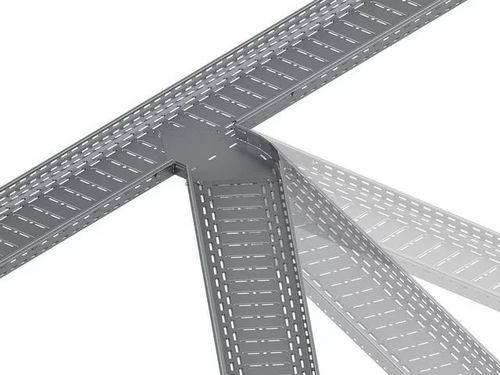What is a metal cable tray and what is it used for?
In the world of industrial electrical installations, cable cluttering is one of the biggest enemies of safety, efficiency, and maintenance. That’s where the metal cable tray comes into play: a structural system designed to organize, support, and protect electrical wiring in all kinds of professional environments.
These trays are typically made from galvanized steel, stainless steel, or pre-galvanized steel, and offer a resistant, ventilated, and durable structure for routing cables in horizontal or vertical paths. They are commonly used in factories, logistics centers, hospitals, power stations, airports, and any environment where performance and safety are critical.
One of the greatest advantages of metal trays is their resistance to humidity, chemical agents, high temperatures, or harsh outdoor conditions, making them ideal even in the most demanding environments.
At PUK Portacables, with more than 50 years of experience manufacturing electrical support systems, we know that choosing the right tray is not just about price or appearance, it’s a technical decision that directly impacts the safety, compliance, and efficiency of the entire installation.
Key advantages over other cable management systems
The first question clients usually ask is: “Why choose a metal tray instead of PVC or rigid tubing?” The answer is clear: versatility, safety, and long-term performance.
Superior mechanical strength
Metal trays handle higher loads, making them ideal for heavy cabling in medium or high-voltage installations.
Extended lifespan
With treatments such as hot-dip galvanization or stainless steel AISI 304/316, they withstand corrosion and extreme conditions for decades.
Efficient ventilation
Unlike closed conduits, many metal trays (especially perforated or wire mesh types) allow heat dissipation, reducing the risk of overheating.
Quick and easy installation
Systems like EasyConnect Basket Tray© allow tool-free assembly, saving time and labor costs.
For the other models, you can consult our cable trays installation guide.
Regulatory compliance
They meet European standards like DIN EN 61537, ensuring mechanical and electrical safety.
From petrochemical plants to public hospitals, we’ve seen how a well-chosen tray not only improves aesthetics but also prevents incidents, reduces maintenance costs, and avoids compliance issues.
Types of metal cable trays: which one is right for your project?
Not all metal cable trays are the same. The right choice depends on the environment, cable volume, and technical requirements. Here are the most common types:
Perforated cable tray
- Ideal for indoor installations.
- Allows ventilation and heat dissipation.
- Easy visual inspection.
Unperforated cable tray
- Fully enclosed.
- Perfect for dusty or contaminated environments.
- Protects against external agents and spills.
Mesh cable tray
- Lightweight and easy to install.
- Excellent airflow.
- Ideal for data centers or complex routing.
Cable Ladders
- Built for heavy loads and long spans.
- Excellent mechanical strength.
- Ideal for heavy industry and petrochemical applications.
Wide-span systems
- Require no additional structures.
- Useful in raised floors or technical ceilings.
Technical factors to consider when choosing a metal tray
Cable load
How many cables? What is the total weight and fill factor? These define the necessary tray width and type.
Installation environment
- Indoor or outdoor?
- Corrosive, marine, or chemical environment?
- Extreme temperatures?
Compliance and standards
A proper tray must meet key regulations such as:
- DIN EN 61537 – mechanical and electrical safety
- DIN 4102-12 – fire resistance
Ease of assembly
Trays with tool-free joints like EasyConnect Basket Tray© can reduce installation time by up to 40%.
Maintenance
Hospitals and food processing plants often require regular cleaning and cable inspections.
Real-world examples by sector: which tray for each type of installation?
Heavy industry
In steel or chemical plants, ladder-type trays made of stainless steel or hot-dip galvanized steel provide maximum durability and load support over long spans.
Renewable energy (photovoltaics)
In one of our featured projects, we developed a full substructure for a photovoltaic plant, integrating metal cable trays with solar module foundations.
See project on PUK Portacables
Public infrastructure
In hospitals, airports, and universities, trays must meet fire resistance standards and require low maintenance. Solid or perforated trays with fire-retardant coatings are commonly used.
Oil and gas sector
ATEX zones require special coatings and full technical documentation. Pre-installation consulting and compliance certificates are crucial to avoid penalties.
Common mistakes when selecting a metal tray
Avoid these frequent errors:
- Choosing based on price instead of actual requirements.
- Failing to calculate the total cable load.
- Ignoring sector-specific regulations.
- Using generic or incompatible accessories.
The solution: Always rely on expert technical guidance from the project planning phase.
Sustainability and responsible materials
In data centers and public buildings, metal trays manufactured with responsible processes are increasingly valued. Traceability and environmental certifications can be decisive in public tenders and sustainable projects.
Conclusion: the impact of a good tray selection on project success
Choosing the right metal cable tray guarantees long-term performance, safety, and legal compliance.
At PUK Portacables, we provide expert technical support, full documentation, and customized solutions from design to execution.
FAQ – Frequently Asked Questions About Metal Cable Trays
What are the advantages of a metal cable tray over a PVC one?
Greater strength, durability, and regulatory compliance.
Which is the best tray for outdoor installations?
Hot-dip galvanized or stainless steel tray.
What standards regulate these systems?
DIN EN 61537 and DIN 4102-12, depending on the environment.
Are they compatible with photovoltaic installations?
Yes. There are treated versions designed to withstand UV rays, water, and extreme climates.
